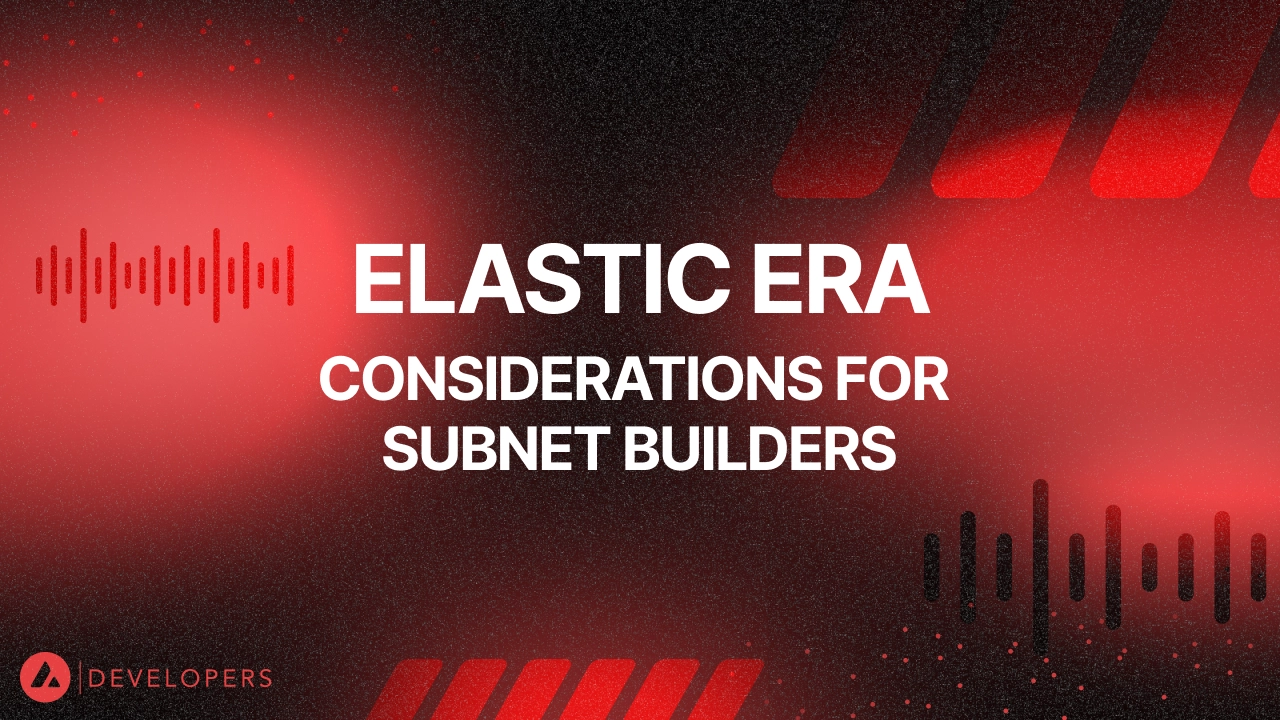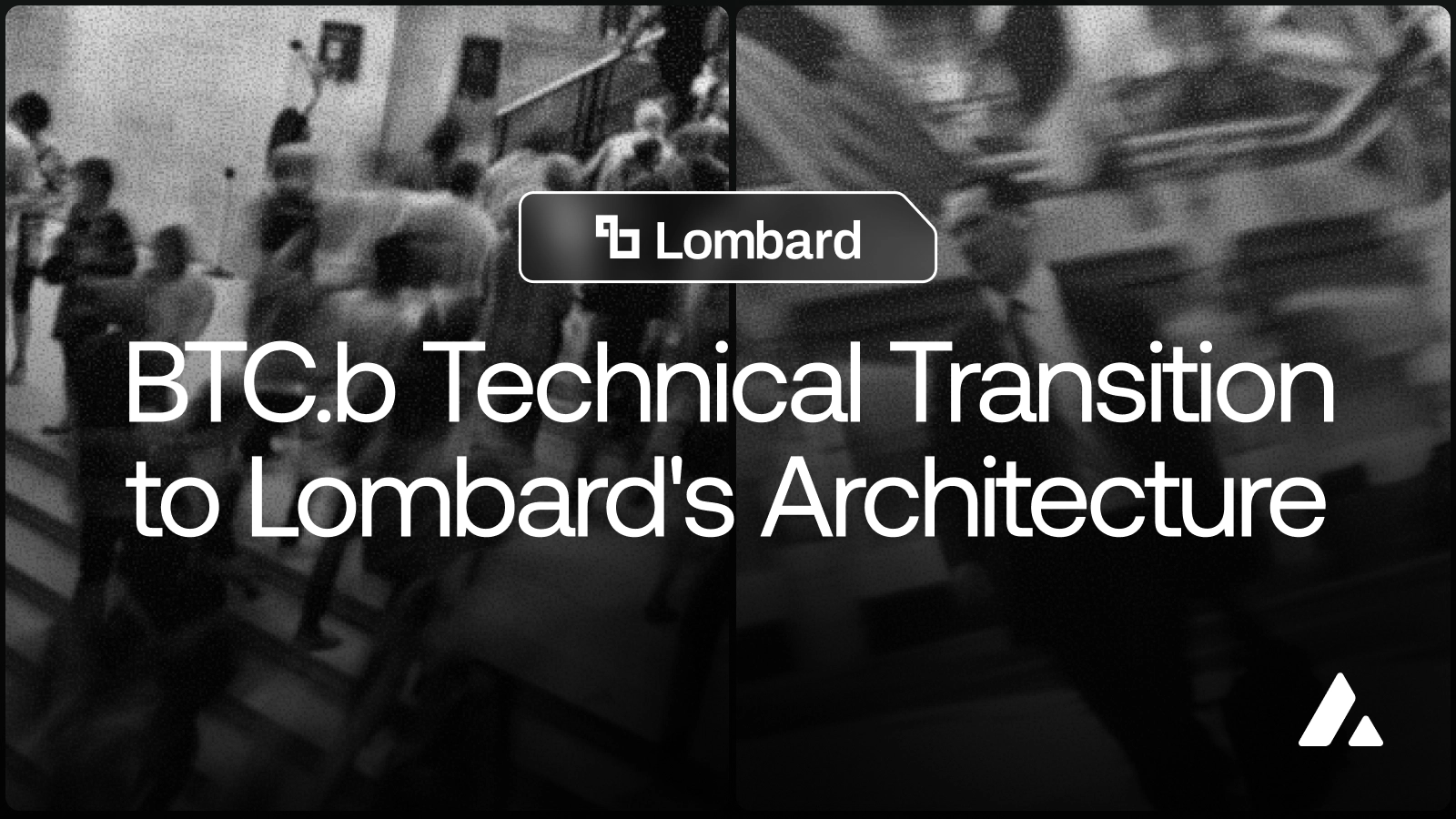Elastic Era: Considerations for Subnet Builders
Elastic Era: Considerations for Subnet Builders
Aug 15, 2023 / By Avax Developers / 12 Minute Read

Diving into the elastic nature of Avalanche Subnets and ways that builders can optimize.
Rumor has it that you want to build a Subnet.You have come to the right place.
Start by reading the Subnet documentation which will get you up to speed on the technical aspects of subnets to get you excited about the bespoke nature of Subnets.
Elastic Subnets are a completely different beast. They allow for permissionless validation, and as such, rely on economic incentives to function and grow. There are several levers you can pull when architecting a token model for your elastic Subnet. Almost all of them represent a trade-off, which is why the first thing you’ll have to define is what you’re optimizing for.
There are no wrong answers when it comes to optimization, as it’ll depend on your use case and goals. It could be user acquisition, network distribution, performance, interoperability, accessibility, community building, or really anything else. Naturally, you will want to pick everything, but you should try to narrow it down or at least get a sense of what to prioritize.
The goal of this blog is to present many of the parameters that you should consider as well as their significance for validator and user bootstrapping. You will find practical examples that can be used as a reference. There is no playbook set in stone to follow, and we expect to see more experimentation with token models for Subnets in the future.
Elastic Subnets: Parameters to Consider

Inline image from: Elastic Era: Considerations for Subnet Builders
Let’s start by laying out all the different Subnet parameters that you can tinker with to achieve your desired result:
Staking Token
A staking token is the token that validators must stake to be eligible to validate the elastic Subnet.
The staking token can’t be a large cap / very liquid token in most cases because nefarious actors could cause issues with the Subnet if they purchase a large amount of the token and try to take over the elastic Subnet based on stake weight or the number of validators.
For example, if someone made their staking token Bitcoin, a nefarious actor with enough capital could buy a large amount of Bitcoin and try to take over majority control/halt the Subnet without substantially impacting the price of Bitcoin.
To ensure proper levels of decentralization of the underlying token, Cosmos airdrops the new token to many people that stake/delegate to validators.
Subnet creators need to ensure that bad actors can’t purchase enough tokens on the market to gain control of the Subnet. There is a natural incentive to do so if the value held on the Subnet > the cost to acquire control.
Staking Min. Threshold
The staking min. threshold is the minimum staking amount of a token needed in order to run a validator.
This needs to be carefully balanced. The trade-off is between accessibility and security.
Delegations
Delegation minimum duration and amount can be changed based on the Subnet creator.
More delegations increase security/decentralization and increase fees for validators.
Delegation fees can be set by the Subnet creator or the Subnet creator could allow the validator to choose what delegation fees are.
Staking Emissions & Duration
The base staking emission rate can set as a baseline inflation for the token. This can be adjusted over time based on predetermined functions.
Custom lockup periods can be enforced.
Gas Token
Dual gas tokens could be something to explore.
Gas abstraction is possible.
The Subnet creator could use a precompile with a gas relayer address.
Gas fees could also be subsidized using gas fees from the largest gas spenders on the Subnet to incentivize split usage and good actors.
Biconomy and Gelato are good third-party options for gas abstraction.
Gas token can be a stablecoin.
Gas Fee Structure
All Gas Fees Burnt
Similar to the current Avalanche C-Chain architecture in regards to gas fees, all gas fees could be burnt instead of going to validators while having a stake amount-based function of token emissions directly being used for incentivized validation.
EIP 1559 Partial Burn
EIP 1559 brought in a partial burn of Ethereum as the fee structure changed from the first-price auction as the main gas fee calculation to having a base fee and a tip. The base fee was now burnt and a tip and block reward were given to validators. During times of congestion, the fees that are burnt can outpace the block rewards being generated, therefore making a gas token deflationary.
Fee splitting
Redirecting fees to custom addresses or contracts (treasury, protocol subsidies, incentives, buybacks, etc.) or back to Subnets validators as rewards (see below).
Validator Revenue
Escrowed Validator Rewards
For fewer token emissions to be flooded onto the market, staking rewards could be escrowed and unlock the tokens the validator must continue to stake. This could be time-weighted with the older validators having a much faster unlock period, or it could be based on a different parameter for vesting (eg. activity, uptime).
Dual Token Rewards
The Subnet creator could opt to do a dual token staking/gas reward model in which validators could get paid the gas token, such as a stablecoin like USDC, as well as the protocol native token in the form of some constant staking emission formula
Validator Services
Validators can issue their own Liquid Staking Derivative for additional revenue, or be encouraged to provide useful services at a cost (making their RPCs accessible for data for eg.).
User & Validator Bootstrapping

Inline image from: Elastic Era: Considerations for Subnet Builders
The next piece of the puzzle is figuring out how to properly bootstrap your validator ecosystem and ensure proper levels of decentralization. This is important so that liveness is not an issue and bad actors cannot halt or take over your Subnet. Another factor to consider is how the economic value of the token determines the security of the Subnet through validator access and requirements. Because Subnets may contain and secure a large amount, they are susceptible to being targeted.
Validator Airdrop
Rewards can vest based on flexible criteria for optimization (eg. uptime).
Could be directed to validators of the primary network similar to Cosmos airdropping Osmosis and Cosmos validators/delegators.
An airdrop can also target delegators or non-validating nodes, assuming it covers minimum stake.
Could have the tokens escrowed and only unlockable by validation with some sort of cliff.
Could also have the escrowed tokens vest from doing certain desired network activities, for example LPing on a DEX, doing a minimum number of transactions per week, TVL put into DeFi or gas usage.
Subsidized Validation
Cloud computing or hardware costs can be subsidized by the Subnet creator to ensure easy and free validation of the Subnet, this can be done for a set period and then transitioned as a cost to those running the validator, like a free trial for a service.
Incentivized Testnet
Can be either geared at users or validators (rewarding activity on testnet dApps or simply rewarding validating for some time on testnet).
Paying Validators Protocol Revenues
If the team is operating an appchain with a protocol that has revenue such as a DEX, debt originator, or borrow/lending market, the fees or revenue generated from the underlying protocol could be used to further incentivize validators. Paying validators with both token emissions and a portion of protocol fees would make the rates very attractive compared to other DeFi yields. These rewards could be given retroactively on a monthly or quarterly basis.
Token Call Option
Validators could be incentivized that if they validate from the inception of the elastic Subnet, or a certain date for a specified period, they receive a token call option at a relatively low strike price.
Incentivized MEV
The Subnet creator could run a similar program to Arbitrum’s “Time Boost” program, but instead of users or searchers getting priority based on gas or validator stake weight, the creator could optimize for the number of validators thus giving more incentive for those wanting to do MEV to run more validators.
Practical Bootstrapping Examples

Inline image from: Elastic Era: Considerations for Subnet Builders
Over the past few years, a variety of blockchains and networks have had to figure out the way to bootstrap their validator ecosystem for proper decentralization and the total number of validators. The Cosmos ecosystem has done this and launched new chains without much issue. Usually, an airdrop is a good way to diversify token holders, delegators, and validators. This can be done in many ways such as to validators/delegators of a particular chain, retroactively, with a vesting component, or through an incentivized testnet.
Avalanche: Denali Testnet (2020)
Denali was Avalanche’s final incentivized testnet before mainnet launch
Attracted over 1,000 validators participating
KYC required
Up to 2,000 AVAX could be earned by a single participant.
The challenge was parameterized to allow participants who completed all the tasks to acquire the 2,000 AVAX required to run a validator node at mainnet launch
Aptos Airdrop & Incentivized Testnet (2022)
Aptos ran three Aptos Incentivized Testnets (AIT) before mainnet launch.
AITs focused on getting the community to deploy initial validators with node liveness criteria.
Full reward of 500 APT for any participant meeting all the criteria and a partial reward of 300 APT for meeting 50% of the criteria.
Bonus reward of 200 tokens for upgrading node & being in the top 10%.
Bonus 150 tokens for minting a testnet NFT.
In total, 23,454,750 APT tokens were airdropped to 124,828 participants.
Web2 auth required to claim the airdrop, limited to certain geographies.
Retroactive Airdrops: Arbitrum (2022 & 2023)
11.62% of the total token supply was offered to users during retroactive airdrop.
Qualifying actions:
Bridging (with different tiers for amount bridged: 0, $10k, $50k, $250k).
Conducting transactions (with different tiers: 0, $10k, $50k, $250k).
Conducting regular transactions over a period (2 months, 6 months, 9 months).
Conducting X transactions with more than X different smart contracts (X = 10, 25, 100).
All of the qualifying actions above earned users points with followed a scale to be converted to tokens, with a certain weighting for each action.
Anti-sybil measures were taken:
If an airdrop recipient’s wallet transactions have all occurred within 48 hours, one point is subtracted.
If an airdrop recipient’s wallet balance is less than .005 ETH, and if the wallet hasn’t interacted with more than one smart contract, one point is subtracted.
If an airdrop recipient’s wallet address has been identified as a Sybil address during the previous program, the recipient is disqualified.
DeFi Kingdoms Migration
DeFi Kingdoms launched a new token, CRYSTAL, when releasing Crystalvale on their own Avalanche Subnet.
CRYSTAL was airdropped to those users who staked the native DeFi Kingdoms DEX token on Harmony called JEWEL.
JEWEL-xJEWEL liquidity pool was incentivized with CRYSTAL incentives, allowing users to pool their existing tokens to receive the CRYSTAL token.
Staking JEWEL tokens to receive xJEWEL also allowed users to earn CRYSTAL.
The goal was to incentivize users to migrate their tokens and liquidity to receive the new token.
An idea that was presented was airdropping permanent LP positions to users that they could not withdraw but got CRYSTAL farming rewards from, therefor it would help build DEX liquidity and reward early DeFi Kingdoms users.
EVMOS Airdrop
Eligibility for participants of the ATOM governance vote that funded EVMOS
Eligibility for ATOM & Osmosis delegators
Airdrop for LPs in OSMO pools (OSMO/AKT, ATOM/AKT, OSMO/UST LPs.)
Airdrop for IBC users
Airdrop for users of top applications on Ethereum (chosen by a combination of TVL & gas guzzler status)
Airdrop for users of top EVM bridges (Avalanche Bridge, Wormhole, Anyswap, Synapse, etc.)
Rektdrop for users that recently got rugged (CREAM, Iron Finance, Pickle)
The minimum token threshold for some actions to be included (not announced in advance)
Following this model, a case could be made for any Avalanche Subnet to airdrop to delegators & validators of the primary network + Subnets, as well as users of main dApps on C-Chain.
Axelar
Incentivized testnet, running for 6 weeks with over 6,500 signups
Specific tasks weren’t made clear to the public but involved setting up a validator to receive rewards
Osmos Builders Airdrop: a snapshot of past transactions to reward Axelar and Osmosis communities that supported cross-chain liquidity by securely bridging assets to Osmosis.
Eligibility: Osmosis addresses that bridged and LP’d Eligible Assets during the Eligibility Window
Fixed payment of 500 AXL + Activity-based payment (based on amount bridged, the volume of activity, time spent in LP pool, etc.)
Injective
Injective Equinox Staking Testnet
Rewards for both delegators & validators
Baseline APY (3%) for transferring INJ (ERC-20 version) to the Injective Chain & Delegating INJ to a validator
APY boosts (+0.5%-3%) for completing specific tasks: Claim & re-stake, re-delegate, participating in governance votes, proposing new market for listing, successful market proposal, “special epic tasks”.
Optimism Airdrops
Airdrop 1: over 200m $OP was airdropped to a total of 248,699 eligible addresses. The amount of $OP allocated to each address ranged from 409.42 up to 27,534.98 $OP
Eligibility criteria:
Optimism users
Repeat Optimism Users
DAO Voters
Multisig Signers
Gitcoin Donors (on L1)
Users Priced Out of Ethereum
Airdrop 2: 1,742,277.10 $OP to 307,965 addresses based on a snapshot taken on 20th January 2023, based on quantity delegated and how long it was delegated.
Governance delegation reward (minimum of 20 OP delegation time multiplier)
Gas usage reward (fee rebate of 80% with minimum gas spent requirement).
With the proper level of decentralization both for validators and a token, an elastic Subnet can launch with proper safety. Launching the validator set in a permissioned setting and building towards further security and decentralization over time is what most teams aim to do.
Using Avalanche Consensus, theoretically, Subnets could scale to tens of thousands of validators, and by having the perfect elastic Subnet token model a team could achieve this goal. Elastic Subnets will play a crucial role in adopting the Avalanche tech stack soon and as more AVAX is locked, it provides a benefit to the whole ecosystem as security is increased and tokens are taken out of circulation.
One can see from the image below the proliferation of Subnets within a testnet environment, each of these Subnets that go to mainnet will need its own validator set which will lead to intense competition as each Subnet tries to win over more validators. Having the perfect combination of early validator bootstrapping along with token value accrual and well-rounded incentivization will guide more teams toward adopting elastic Subnets and push the Subnet economy forward.

Inline image from: Elastic Era: Considerations for Subnet Builders
Written by Matthew Schmenk and Nadim Chamoun, get in touch to talk about building on Avalanche!




